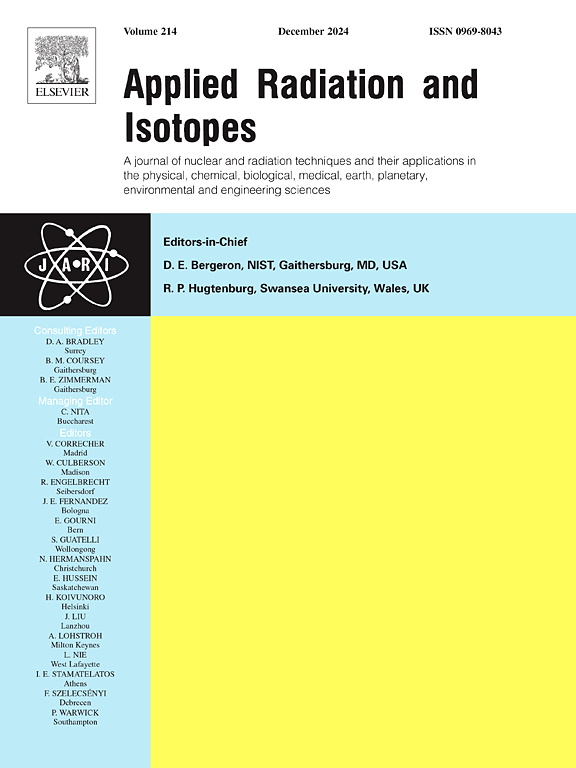用PVA-GTA-I放射致色凝胶剂量计评价中子俘获治疗中三维剂量分布的初步研究
IF 1.8
3区 工程技术
Q3 CHEMISTRY, INORGANIC & NUCLEAR
引用次数: 0
摘要
硼中子俘获疗法(BNCT)是一种很有前途的癌症治疗方法,它利用硼与热中子之间的核反应。三维(3D)凝胶剂量计因其评估BNCT三维剂量分布的潜力而受到关注。本文研究了PVA- gta - 1(戊二醛与碘化物交联的聚乙烯醇)放射致色凝胶剂量计,该剂量计由于PVA与碘化物形成络合物而呈现红色。用中子敏化剂10B和6Li增强了pva - gta - 1凝胶剂量计,并用核反应堆的中子进行辐照。作为未来评估三维剂量分布的初步实验,我们通过测量小凝胶剂量计系统的吸光度变化来评估伪一维深度剂量分布。结果表明,当中子敏化剂存在时,PVA-GTA-I凝胶剂量计可以检测到中子捕获反应引起的剂量增加。伪一维深度剂量分布的形状与简单的模拟相吻合。这些发现提示了未来使用大凝胶剂量计和三维光学计算机断层扫描设备进行三维剂量分布测量的潜力。本文章由计算机程序翻译,如有差异,请以英文原文为准。
Preliminary study of 3D dose distribution evaluation in neutron capture therapy using a PVA-GTA-I radiochromic gel dosimeter
Boron neutron capture therapy (BNCT) is a promising cancer treatment method that utilizes the nuclear reaction between 10B and thermal neutrons. Three-dimensional (3D) gel dosimeters are gaining attention for their potential to assess 3D dose distributions in BNCT. In this study, a PVA-GTA-I (polyvinyl alcohol crosslinked by glutaraldehyde, and iodide) radiochromic gel dosimeter, which develops a red color due to complex formation between PVA and iodide, was investigated. A PVA-GTA-I gel dosimeter, enhanced with neutron sensitizers 10B and 6Li, was irradiated with neutrons from a nuclear reactor. As a preliminary experiment for future evaluation of 3D dose distribution, we assessed a pseudo-one-dimensional depth dose distribution by measuring absorbance changes in a system of small gel dosimeters. The results showed that the PVA-GTA-I gel dosimeter could detect increased doses resulting from neutron capture reactions when neutron sensitizers were present. The shape of the pseudo-one-dimensional depth-dose distribution correlated well with a simple simulation. These findings suggest the potential for future 3D dose distribution measurements using large gel dosimeters and 3D optical computed tomography devices.
求助全文
通过发布文献求助,成功后即可免费获取论文全文。
去求助
来源期刊

Applied Radiation and Isotopes
工程技术-核科学技术
CiteScore
3.00
自引率
12.50%
发文量
406
审稿时长
13.5 months
期刊介绍:
Applied Radiation and Isotopes provides a high quality medium for the publication of substantial, original and scientific and technological papers on the development and peaceful application of nuclear, radiation and radionuclide techniques in chemistry, physics, biochemistry, biology, medicine, security, engineering and in the earth, planetary and environmental sciences, all including dosimetry. Nuclear techniques are defined in the broadest sense and both experimental and theoretical papers are welcome. They include the development and use of α- and β-particles, X-rays and γ-rays, neutrons and other nuclear particles and radiations from all sources, including radionuclides, synchrotron sources, cyclotrons and reactors and from the natural environment.
The journal aims to publish papers with significance to an international audience, containing substantial novelty and scientific impact. The Editors reserve the rights to reject, with or without external review, papers that do not meet these criteria.
Papers dealing with radiation processing, i.e., where radiation is used to bring about a biological, chemical or physical change in a material, should be directed to our sister journal Radiation Physics and Chemistry.
 求助内容:
求助内容: 应助结果提醒方式:
应助结果提醒方式:


